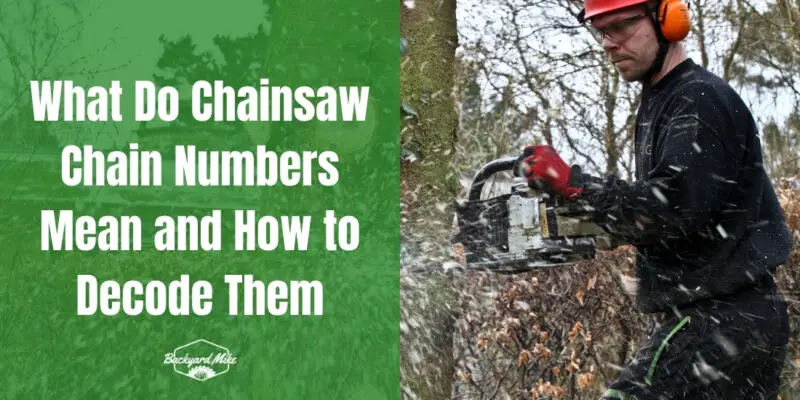Chainsaw chain numbers indicate key details like pitch, gauge, and drive links, essential for selecting the right chain. Pitch, the distance between consecutive rivets, affects compatibility with saw sprockets. Gauge measures drive link thickness, guaranteeing a proper fit in the guide bar. Drive link count must match the saw's specifications for safe operation. Decode manufacturer codes to understand specific features and avoid mismatches. Getting these right guarantees safe and efficient cutting, enhancing your chainsaw know-how even more.
Key Takeaways
- Chainsaw chain numbers provide information on pitch, gauge, and drive links for compatibility and performance.
- Pitch is calculated by dividing the distance between three rivets by two, affecting chain fit.
- Gauge refers to the drive links' thickness, ensuring a proper guide bar fit.
- Matching drive link count with manufacturer specifications is crucial for safe and efficient operation.
- Manufacturer codes may indicate cutter type or additional features for specific chain functionalities.
Understanding Chainsaw Chain Components
Chainsaw chains are intricate systems made up of several key components that work together to guarantee efficient cutting performance. You'll find cutting links, which include parts like the top plate and cutting corner, essential for slicing through wood with precision. Drive links guide the chain along the bar, ensuring stability and even oil distribution, which is crucial for smooth operation. Understanding the gauge of the chain is essential, as it ensures that the chain operates smoothly within the guide bar. Tie straps connect the drive links and cutting links with rivets, forming a cohesive chain. The depth gauge, or raker, controls the depth of each cut, preventing over-penetration. Together, these components form a balanced system, ensuring your chainsaw operates effectively. Understanding these elements helps you maintain your chainsaw, ensuring it serves you well in your cutting tasks. Additionally, regular maintenance of your chainsaw chain is important to extend its life and ensure optimal performance for various cutting tasks.
Decoding the Chain Number Format
Understanding the chain number format is vital for guaranteeing your chainsaw functions properly. Chain numbers provide a chain specifications overview, revealing details like pitch, gauge, and the number of drive links. These parameters are essential for compatibility with your chainsaw, guaranteeing it operates smoothly. Mismatches can lead to performance issues or improper fits. Each manufacturer, such as Stihl or Husqvarna, may include unique codes that demand a manufacturer codes explanation for accurate decoding. These codes might indicate specific features like cutter type or special tie straps. By familiarizing yourself with these codes and chain specifications, you guarantee your chainsaw is equipped with the right chain, promoting safety and efficiency. Always consult manufacturer documentation for precise decoding guidance. Accurate specifications, including pitch, gauge, and number of drive links, are essential for successful chain ordering.
Identifying Pitch and Gauge
To identify the pitch and gauge of your chainsaw chain, start by understanding what each term means and how it affects your tool's performance.
Pitch measurement techniques involve measuring the distance between three consecutive rivets and dividing by two. This determines if the chain fits the sprocket and impacts cutting efficiency. Common pitches are 0.325", 3/8", and 0.404". Measuring tools are essential for identifying correct chain specifications, ensuring that the chain fits properly and maintains the chainsaw's performance. Chainsaw chains with a low kickback design are recommended for enhanced safety during cutting tasks.
For gauge selection criteria, gauge refers to the drive links' thickness, guaranteeing a proper fit in the guide bar. Use a vernier caliper for precise gauge measurement, with sizes like 0.043", 0.050", 0.058", and 0.063".
Check your chainsaw manual for correct specifications. Choosing the right pitch and gauge guarantees peak performance and safety, fostering a sense of belonging in your tool maintenance community.
Counting Drive Links Accurately
Before you can guarantee your chainsaw chain fits perfectly, it's important to count the drive links accurately. Start by laying the chain flat on a stable surface, verifying it's clean for easier counting.
Use manual counting techniques by physically counting each link individually. For added accuracy, adopt systematic counting methods such as counting in pairs. Move your fingers along the chain, link by link, to avoid miscounting. Wearing gloves can enhance safety as you handle the chain.
If the chain lacks marked links, rely on manual counting without the need for tools. Remember, a correct drive link count confirms proper chain tension, preventing derailment or binding. Ensuring the number of drive links matches the manufacturer's recommended specifications is essential for maintaining the chainsaw's performance and safety.
With these steps, you'll confirm your chainsaw operates smoothly and safely.
Choosing the Right Chain Type
When choosing the right chain type for your chainsaw, it's crucial to understand how different chains meet specific cutting needs.
Full chisel chains, with their aggressive square-cornered teeth, excel in dense wood, offering high chain performance metrics.
Excelling in dense wood, full chisel chains boast aggressive square-cornered teeth for superior cutting performance.
For balanced performance and durability, semi-chisel chains are versatile, suitable for general cutting tasks. Semi-chisel chains are also less prone to dulling compared to full chisel options, making them ideal for beginners and those looking for lower maintenance.
Low-profile chains provide precision, perfect for light-duty tasks like pruning.
If you're dealing with hard materials, diamond-tipped chains cut through with ease, while carbide-tipped chains promise exceptional durability for long-term use.
To maintain peak performance, follow chain maintenance tips: regularly sharpen your chain, check tension, and guarantee proper lubrication. Additionally, accurate measurements of pitch, gauge, and drive links ensure proper fit and function for optimal chainsaw performance.
Ensuring Chain Compatibility and Fit
Understanding how to choose the right chain type is only part of the equation; guaranteeing that chain compatibility and fit are correct is equally important for ideal chainsaw performance.
Start by checking the pitch, gauge, and chain length to match your chainsaw's specifications. You can find these details on the saw or in the user manual. Proper chain fit guarantees effective lubrication, reducing wear and enhancing your chainsaw's efficiency. A well-fitted chain also prevents jamming and misfitting, which can lead to operational issues. In addition to these factors, proper chain selection ensures safety and efficiency in wood cutting projects. Regular chain maintenance, like sharpening and cleaning, keeps your chain in top condition.
Always use the right tools, like a vernier caliper for gauge measurement, to guarantee accuracy and maintain the longevity of your chainsaw.
Addressing Common Chain Issues
When addressing common chain issues, you should pay attention to chain wear indicators, pitch mismatch problems, and link count errors. Regularly inspect the chain for wear signs, ensuring the pitch matches the sprocket and bar for proper operation. Count the links carefully to avoid errors that can lead to improper tension or fit, affecting the chainsaw's performance and safety. The chain size must match the specific chainsaw model for optimal performance, as improper sizing can lead to reduced performance and potential damage.
Chain Wear Indicators
Chain wear indicators are essential for guaranteeing your chainsaw's efficiency and safety. They help you identify when your chain is worn out, allowing you to replace it before performance declines. Located on the teeth or other chain parts, these indicators provide visual cues for wear. Following chain maintenance tips, like regular sharpening and tensioning, can help prolong the chain's life. Use wear measurement tools, such as vernier calipers or chain wear kits, to assess the condition accurately. These tools help you monitor the chain's elongation and guarantee sprockets are within safe limits. For harsh and corrosive environments, it's recommended to use chain wear indicators made from high-quality materials to ensure accurate measurements every time.
Pitch Mismatch Problems
While monitoring chain wear guarantees your chainsaw's safety, addressing pitch mismatch problems is equally vital for peak performance. A pitch mismatch occurs when the chain's pitch doesn't align with the saw's sprocket, leading to improper tension and safety risks. Incorrect pitch measurement often results from miscounting rivets, decreasing cutting efficiency and increasing wear. The pitch size determines the spacing of the chain links and ensures compatibility with specific chain systems. To avoid such issues, consult your chainsaw manual for precise pitch specifications. If you're unsure, seek professional advice for troubleshooting techniques. Regularly checking that your guide bar and sprocket match the chain's pitch guarantees compatibility. For chains needing replacement, precise pitch measurement is essential.
Link Count Errors
To address link count errors in your chainsaw chain, start by ensuring the drive link count matches your saw's bar specifications. Incorrect drive link counts can lead to drive link discrepancies, affecting both performance and safety. If the chain is too short, it won't fit; too long, and it risks bottoming out the adjustment screw, limiting tension adjustments. Long bars may exhibit cumulative errors in drive link count, which can exacerbate fitting issues. Use chain adjustment techniques to maintain proper tension, reducing the risk of derailment and bar damage. Regularly check the drive link count against the bar's recommended specifications, often printed on the bar or found in the manual. For accuracy, count drive links with gloves for safety, or consult an expert for guidance. This proactive approach keeps your chainsaw running smoothly and safely.
Frequently Asked Questions
How Do I Measure Chainsaw Chain Tension Correctly?
You'll guarantee proper chainsaw maintenance by checking chain tension regularly. Use a tension gauge or manually pull the chain slightly away from the sprocket. Adjust as needed, confirming it's neither too tight nor too loose for safe operation.
What Is the Best Method to Clean a Chainsaw Chain?
Think of your chainsaw chain as a dance partner; treat it well, and it performs beautifully. For effective cleaning, soak in degreaser, scrub with a wire brush, rinse, dry, and protect with WD-40. Embrace these chainsaw maintenance tips.
How Often Should I Replace My Chainsaw Chain?
You'll want to replace your chainsaw chain every 25 to 40 hours of use. Pay attention to wear markers, dull teeth, and increased vibration as indicators. Regular maintenance and inspection can help you feel confident in your equipment.
What Are Signs of a Dull Chainsaw Chain?
When your chainsaw dances like a tired marathoner, it's time for maintenance. Check for uneven cuts and fine sawdust, then apply chain sharpening techniques. Embrace these chainsaw maintenance tips, ensuring you're part of the chainsaw-savvy community.
Can I Use Any Lubricant for My Chainsaw Chain?
You can't use just any lubricant for your chainsaw chain. Choosing the right lubricant types is essential for chain maintenance, ensuring efficiency and extending lifespan. Join others who prioritize proper care and enjoy smooth, reliable performance.
Conclusion
When you're dealing with chainsaw chains, understanding the numbers is vital for choosing the right one. Did you know that a mismatched chain can decrease efficiency by up to 20%? By decoding the chain number format, identifying pitch and gauge, and counting drive links accurately, you guarantee the chain fits and functions properly. Always check compatibility and address common issues promptly to maintain performance. Use this knowledge to select the best chain and enhance your chainsaw's effectiveness.


